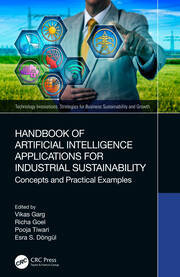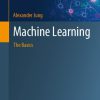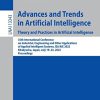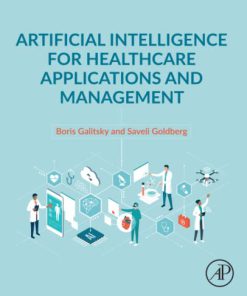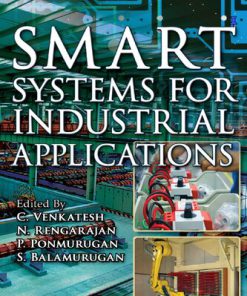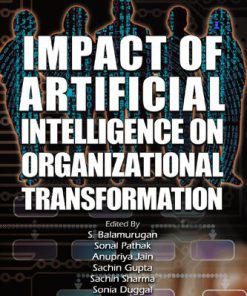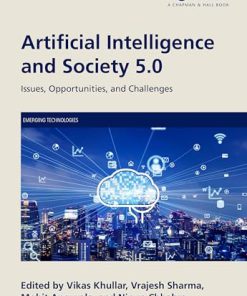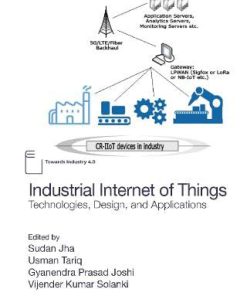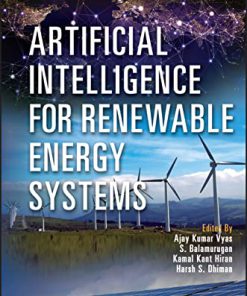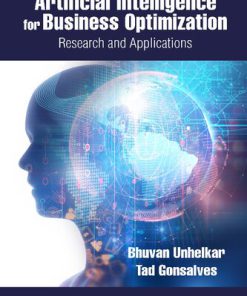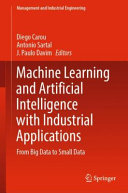Handbook Of Artificial Intelligence Applications For Industrial Sustainability 1st Edition by Vikas Garg, Richa Goel, Pooja Tiwari, Esra Sipahi Döngü 1000991520 9781000991529
$50.00 Original price was: $50.00.$25.00Current price is: $25.00.
Handbook Of Artificial Intelligence Applications For Industrial Sustainability 1st Edition by Vikas Garg, Richa Goel, Pooja Tiwari, Esra Sipahi Döngü – Ebook PDF Instant Download/Delivery: 1000991520, 9781000991529
Full download Handbook Of Artificial Intelligence Applications For Industrial Sustainability 1st Edition after payment
Product details:
ISBN 10: 1000991520
ISBN 13: 9781000991529
Author: Vikas Garg, Richa Goel, Pooja Tiwari, Esra Sipahi Döngü
The subject of Artificial Intelligence (AI) is continuing on its journey of affecting each and every individual and will keep on this path in the times to come. This handbook is a collection of topics on the application of artificial intelligence applications for sustainability in different areas. It provides an insight into the various uses of concepts and practical examples for different domains all in one place, which makes it unique and important for the potential reader. Handbook of Artificial Intelligence Applications for Industrial Sustainability: Concepts and Practical Examples examines the influence of AI and how it can be used in several industries to improve corporate performance, reduce security concerns, improve customer experience, and ultimately generate value for customers and maximize profits. The handbook offers practical examples, concepts, and applications that provide an easy understanding and implementation process. It provides AI applications in many fields, such as sustainable credit decisions, cyber security and fraud prevention, warehouse management, and much more. This handbook will provide insight to customers, managers, professionals, engineers, researchers, and students on the various uses of AI and sustainability in different domains. All of this needed information compiled into one handbook makes it unique and important for the engineering, business, and computer science communities.
Handbook Of Artificial Intelligence Applications For Industrial Sustainability 1st Table of contents:
1 Artificial Intelligence Application for Enterprise Sustainability
1.1 Introduction
1.2 Research Findings and Results
1.3 Design and Method
1.4 Findings and Discussion
1.5 Conclusion and Recommendations
Notes
References
2 Artificial Intelligence Models in Pattern Recognition
2.1 Introduction
2.2 Theoretical Approaches to Pattern Recognition
2.2.1 Statistical Classification
2.2.2 Structural Pattern Recognition
2.2.3 Neural Network Pattern Recognition
2.2.4 Models Used in Pattern Recognition
2.3 Real-World/Industrial Application of Pattern Recognition
2.3.1 Robotics
2.3.2 Computer Vision
2.3.3 Biomedical and Biology
2.3.4 Speech Recognition
2.3.5 Oil and Gas
2.3.6 Identification of Fingerprints
2.3.7 Financial Industry Services
2.3.8 Natural Language Processing
2.3.9 Handwriting Recognition
2.3.10 Credit Scoring
2.3.11 Anomaly Detection
2.3.12 Supporting Healthcare Professionals and Protecting Patients
2.4 Conclusion
References
3 Efficient Techniques for Disease Prediction from Medical Data
3.1 Introduction
3.2 Objectives
3.3 Methodology
3.4 Machine Learning in Disease Prediction
3.5 Data Mining in Disease Prediction
3.6 Techniques for Data Mining
3.6.1 Techniques for Data Mining
3.7 Fundamentals of Data Mining
3.7.1 Data Mining Fundamentals
3.8 Issues and Difficulties in Disease Prediction
3.9 Algorithm of Machine Learning in Medical Data
3.10 Future of Machine Learning and Data Mining in the Healthcare Sector
3.11 Conclusion
References
4 Understanding the Contribution of Artificial Intelligence
4.1 Introduction
4.2 Scope and Objectives of the Study
4.3 Literature Review
4.4 Role and Application of Technologies and Tools Powered by Artificial Intelligence
4.5 Findings
4.6 Conclusion
4.7 Managerial Implications
References
5 Artificial Intelligence and Sustainable Green Fashion Industry
5.1 Introduction
5.2 Artificial Intelligence for Sustainable Material
5.3 Artificial Intelligence for Design Process
5.4 Artificial Intelligence for Predictive Analytics and Demand Forecasting
5.5 Artificial Intelligence for Operations Automation
5.6 Product, Inventory, and Supply Chain Management
5.7 Artificial Intelligence for Customer Experience Enhancement Online and In-Store
5.7.1 Chatbots or Artificial Intelligence Smart Assistants
5.7.2 Image Search
5.7.3 Reverse Image
5.7.4 Visual Search
5.8 Subscription Services and Recommendations Engines
5.8.1 Brand Subscriptions
5.8.2 Targeted Subscriptions
5.8.3 Rental Subscriptions
5.8.4 Personal Artificial Intelligence Stylist
5.8.5 Amazon’s Echo Look
5.9 Customer Experience Enhancement In-Store
5.10 Conclusion
References
6 Artificial Intelligence for Sustainable Human Resource Management
6.1 Introduction
6.2 Artificial Intelligence
6.3 Artificial Intelligence and Human Resources Management
6.4 Sustainable Human Resources Management in the Era of Artificial Intelligence
6.5 Results
References
7 Relation of Human Resource Management and Artificial Intelligence
7.1 Introduction
7.1.1 What Is Human Resources Management?
7.1.2 What Is Artificial Intelligence?
7.1.3 Concept of Organization Culture
7.1.4 Defining Organization Culture
7.1.5 Characteristics of Organization Culture
7.1.6 Organization Culture
7.1.7 Definition of Culture
7.1.8 Seven Unique Features of Organization Culture
7.1.9 Types of Organization Culture
7.1.10 Weak Culture
7.1.11 Dimensions of Organization Culture
7.1.12 Positive Organization Culture
7.1.13 Work Culture: Dimensions and Various Studies
7.1.14 Artificial Intelligence in Human Resource Management
7.2 Methodology
7.3 Research Design
Results and Discussion
Limitation and Future Research Direction
References
8 Leveraging Artificial Intelligence for Talent Management
8.1 Introduction
8.2 Challenges in Global Talent Management and Strategic Opportunities for Talent Sustainability
8.2.1 Globalization and Allied Challenges
8.2.2 Changing Demographics
8.2.3 Demand for More Competencies and Motivation
8.2.4 Supply of High-Quality Workers
8.2.5 Building a Talent Sustainability Framework
8.3 Three Ts: Technology, Talent Intelligence, and Talent Analytics
8.3.1 Talent Attraction (Recruitment and Onboarding)
8.4 Enabling Artificial Intelligence in Talent Management
8.4.1 Artificial Intelligence Tools for Candidate Sourcing
8.4.2 Candidate Screening Using AI Tools
8.4.3 Candidate Assessment Using Artificial Intelligence Tools
8.4.4 Artificial Intelligence Reshaping Talent Acquisition Process
8.5 Effect of Artificial Intelligence in Sustainable Talent Management
8.5.1 Responsible Talent Management Model
8.6 Conclusion
References
9 Transformation of Human Resources: Future of Workforce Analytics
9.1 Introduction
9.2 Applications or Role of AI in HRM
9.2.1 Workforce Planning
9.2.2 Talent Acquisition and Recruitment
9.2.3 Employee Engagement
9.2.4 Learning and Development Programs
9.2.5 Performance Appraisal
9.3 Transformation of Traditional HR to Contemporary HR Using AI
9.3.1 Relationship between Humans and the Digital
9.3.2 Benefits, Limitations, and Challenges in Implementing the AI in HRM
9.4 Transformation of Traditional HR to Contemporary HR with AI
9.4.1 Benefits, Limitations, and Challenges in Implementing the AI in HRM
9.4.2 Limitations
9.4.3 Challenges
9.5 Policy Recommendations
9.5.1 Constructing a Marketplace
9.5.2 Creating Awareness of the Contribution of AI
9.5.3 Collaboration
9.5.4 An Aid for Start-up
9.5.5 Security and Privacy Issues
9.6 Conclusion
References
10 Fraud Detection with Machine Learning and Artificial Intelligence
10.1 Introduction
10.2 Machine Learning
10.3 Artificial Intelligence
10.4 Frauds
10.4.1 Types of Fraud
10.4.2 Fraud Detection Methods for Credit Cards
10.4.3 Machine Learning–Driven Fraud Detection
10.5 Machine Learning in Fraud Detection
10.5.3 Machine Learning Algorithms and Models for Fraud Detection
10.6 Bottom of Form
10.7 Machine Learning in Fraud Detection
10.8 Characteristics and Challenges
10.9 Conclusion
References
11 Performance of Artificial Intelligence in Fraud Detection
11.1 Introduction
11.2 Methods
11.2.1 Search Criteria (Keywords)
11.3 Analysis and Results
11.4 Conclusion
11.5 Limitation and Future Direction
References
12 Sustainable Education and Differently Abled Students
12.1 Introduction
12.2 Impact of Covid-19 on Education
12.3 Methodology
12.4 Discussion
12.4.1 Strategies to Be Adopted to Sustain Education After the Reopening of Educational Institutions After COVID-19
12.4.2 Impact of Artificial Intelligence on Education for its Sustainability in the Long Run
12.4.3 Role of Educational Data Mining and Neural Networks in Artificial Intelligence Education
12.4.4 Role of Intelligent Tutoring Systems in AIEd
12.4.5 Paradigms in AIEd
12.4.6 Technological Strategies to Be Adopted for Specially Abled Students to Make a More Inclusive Educational System
12.4.7 Solutions that Technology Can Provide for Differently Abled Students
12.5 Future Prospects of the Study
12.6 Study Limitations
12.7 Conclusion
References
13 Artificial Intelligence for Sustainable Agricultural Practices
13.1 Introduction
13.2 Theoretical Framework
13.3 Methods
13.3.1 Questionnaire Development
13.3.2 Hypothesis Development
13.3.3 Data Collection
13.4 Results
13.4.1 Profiling of Respondents
13.4.2 Reliability and Validity
13.4.3 Analysis of Hypothesis
13.5 DISCUSSION
13.6 Conclusion
References
14 Impact of Artificial Intelligence in Personalized Banking Service
14.1 Introduction
14.2 Literature Review
14.3 Study Objectives
14.4 Methodology
14.5 Data Analysis and Interpretation
14.5.1 Customers’ View
14.5.2 Bankers’ View
14.6 Summary and Conclusion
References
15 E-Commerce and Trade: The Role of Artificial Intelligence
15.1 Introduction
15.2 Artificial Intelligence for Personalization or the Internet
15.3 Artificial Intelligence: Cognitive or Perceptual
15.4 Artificial Intelligence: Decision or Business
15.5 Automated Artificial Intelligence
15.5.1 Literature Review
15.5.2 Individual Product Suggestions
15.5.3 Optimizing the Price
15.5.4 Improved Clientele Service
15.5.5 Client Segmentation
15.5.6 Smart Logistics
15.5.7 Forecasting of Demand and Sales
15.6 Artificial Intelligence in E-Commerce Statistics and Facts
15.6.1 Statistics on Artificial Intelligence Adoption in E-Commerce
15.6.2 Statistics on the Role of Artificial Intelligence in Online Sales
15.6.3 Statistics on the Use of Artificial Intelligence in Customer Service
15.7 Conclusion
References
16 Artificial Intelligence Tools for Reshaping E-Business and Trade
16.1 Introduction
16.1.1 Global Leaders: Artificial Intelligence
16.2 Literature Review: Theoretical Background of Electronic Commerce and Artificial Intelligence
16.2.1 Electronic Commerce
16.2.2 Artificial Intelligence: Concepts and its Development
16.3 Emerging Artificial Intelligence Technologies: Reshaping E-Business
16.3.1 Computer Vision
16.3.2 Speech, Text, and Image Recognition
16.4 Artificial Intelligence Transforming E–Business and Economic Sectors: Artificial Intelligence Methods and Functions
16.4.1 Heuristics Artificial Intelligence Method
16.4.2 Machines that Support Vectors
16.4.3 Artificial Neural Networks
16.4.4 Markov Decision-Making
16.4.5 Computer-Aided Natural Language Processing
16.4.6 Fuzzy Logic
16.5 Emerging Artificial Intelligence Trends: Implementing and Promoting E-Business and Trade
16.5.1 Chatbots
16.5.2 Management of Customer Relationships
16.5.3 Achieving Sales Goals
16.5.4 Product Content Management
16.5.5 Customer Service
16.5.6 Automation
16.5.7 Artificial Intelligence Is Everywhere
16.6 Artificial Intelligence Technology: Its Applications in Electronic Business and Trade
16.6.1 Artificial Intelligence Assistant
16.6.2 Engine of Recommendations
16.6.3 Advanced Supply Chain
16.6.4 Maximum Profits
16.7 Artificial Intelligence in E-Business: Case Studies
16.7.1 Amazon
16.7.2 JD.com
16.7.3 Alibaba
16.7.4 eBay
16.7.5 ASOS
16.7.6 Rakuten
16.8 New Electricity in E-Business: Artificial Intelligence
16.8.1 Consumer-Focused Visual Search
16.8.2 Improve Sales Process and Retarget Potential Clients
16.8.3 Higher Degree of Customization
16.8.4 Chatbots and Virtual Helpers
16.8.5 Increase Customer Recommendations
16.8.6 Knowledgeable Actors
16.8.7 Remove Fake Reviews
16.8.8 Automation
16.9 Electronic Commerce and Related Business Domains: Artificial Intelligence Applications
16.9.1 E-Commerce
16.9.2 Retailing
16.9.3 Manufacturing
16.9.4 Marketing
16.9.5 Payments
16.9.6 Supply Chain
16.9.7 Cybersecurity
16.10 Challenges and Issues: Artificial Intelligence
16.10.1 Finding Use Cases that Are Valid
16.10.2 Sorting Out Data
16.10.3 Creating a Department for Artificial Intelligence
16.10.4 Culture and Risk Management
16.11 E-Business and Trade: The Future of Artificial Intelligence
16.12 Discussion and Conclusion
References
17 Robotic Process AutomationThe Emerging Technology
17.1 Concept of Robotic Process Automation
17.2 Evolution of Robotic Process Automation
17.2.1 Technology
17.2.2 Workflow Automation and Management Tools
17.2.3 Artificial Intelligence
17.2.4 Robotic Process Automation: The Emerging Technology
17.3 Distinction Among Manual, Scripted Automation, and Robotic Process Automation
17.3.1 Manual Process
17.3.2 Scripted Automation
17.3.3 Robotic Process Automation
17.3.4 Heavy Weight Vs. Light Weight Automation
17.4 Types of Business Processes Wherein Robotic Process Automation can be Used
17.4.1 Repetitive Tasks That Employees Perform 50–60 Times in an 8-Hour Working Day
17.4.2 Reporting and Analysis
17.4.3 Mass Mail Generation, Archiving, and Extracting
17.4.4 Conversion of Data Formats and Graphics
17.4.5 Enterprise Resource Planning Transactions
17.4.6 Process Lists and File Storage
17.5 Characteristics and Strengths of Robotic Process Automation
17.6 Impact of Robotic Process Automation and Artificial Intelligence
17.6.1 Capgemini (2016) Research Work
17.6.2 Deloitte (2017) Research Findings
17.6.3 Research Works of Lacity and Willcocks (2017)
17.6.4 Research Work of Ian Sandholm (2019)
17.6.5 Research Work of Hindle J, Lacity M, Willcocks L, and Khan S (2018)
17.7 Bottlenecks and Risks
17.8 Conclusion
References
Index
People also search for Handbook Of Artificial Intelligence Applications For Industrial Sustainability 1st :
the cambridge handbook of artificial intelligence
the cambridge handbook of artificial intelligence pdf
a handbook of artificial intelligence in drug delivery
oxford handbook of artificial intelligence
Tags:
Vikas Garg,Richa Goel,Pooja Tiwari,Esra Sipahi Döngü,Artificial Intelligence
You may also like…
Computers - Artificial Intelligence (AI)
Artificial Intelligence for Healthcare Applications and Management 1st Edition Boris Galitsky
Engineering - Robotics & Artificial Intelligence
Business & Economics - Management & Leadership
Computers - Artificial Intelligence (AI)
Engineering - Social & Cultural Aspects of Technology
Technique - Industrial Equipment and Technology
Computers - Artificial Intelligence (AI)
Computers - Artificial Intelligence (AI)
Computers - Artificial Intelligence (AI)

